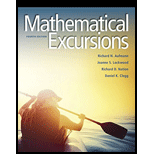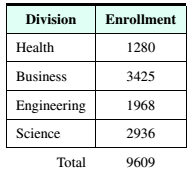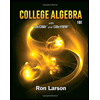
Education The following table shows the enrollments for the four divisions of a college. There are 50 new overhead projectors that are to be apportioned among the divisions based on the enrollments.

a. Use the Hamilton method to determine the number of projectors to be apportioned to each division.
b. Use the Jefferson method to determine the number of projectors to be apportioned to each division.
c. Use the Webster method to determine the number of projectors to be apportioned to each division.
(a)
Use the Hamilton method to determine tile number of projectors to be apportioned to each division.
Answer to Problem 1RE
Hence, the projectors to be apportioned each division Health, Business, Engineering, and Science is
Explanation of Solution
Given Information:
Number of overhead projectors
Concept used:
Calculation:
Since there is a total 50 new overhead projectors should be apportioned standard divisor is calculated by total number of enrollments divided by total number of new over head projectors that are to be apportioned, formula for standard divisor is,
Therefore,
Under the Hamilton plan, divide the enrollments of each division by the standard divisor and round the quotient down to a whole number
| Divisions | Enrollments | Quotient | Standard Quota |
| Health | | | |
| Business | | | |
| Engineering | | | |
| Science | | | |
| Total | | ||
When this happen the Hamilton plan calls for revisiting the calculation of the quotients and assigning an additional representative to the divisions with the largest decimal remaindeí process is continued until the number of representatives equals the number required by divisions. For divisions we have.
| Divisions | Enrollments | Quotient | Standard Quota | Number of overhead projectors |
| Health | | | | |
| Business | | | | |
| Engineering | | | | |
| Science | | | | |
| | |
Hence, the projectors to be apportioned each division Health, Business, Engineering, and Science is
Conclusion:
Hence, the projectors to be apportioned each division Health, Business, Engineering, and Science is
(b)
Use the Jefferson method to determine the number of projectors to be apportioned to each division.
Answer to Problem 1RE
The projectors to be apportioned each division Health, Business, Engineering, and Science is
Explanation of Solution
Given Information:
| Division | Enrollment |
| Health | |
| Business | |
| Engineering | |
| Science | |
| Total | |
Concept used:
Calculation:
For Jefferson plan we consider modified standard divisor by trial and error is
| Divisions | Enrollments | Quotient | Standard Quota |
| Health | | | |
| Business | | | |
| Engineering | | | |
| Science | | | |
| Total | | ||
Hence, the projectors to be apportioned each division Health, Business, Engineering, and Science is
Conclusion:
The projectors to be apportioned each division Health, Business, Engineering, and Science is
(c)
Use the Webster method to determine the number of projectors to be apportioned to each division.
Answer to Problem 1RE
The projectors to be apportioned each division Health, Business, Engineering, and
Science is
Explanation of Solution
Given Information:
Webster method
Concept used:
Webster method includes Enrollment, Quotient and number of overhead projects.
Calculation:
Now use Webster method to determine the number of projectors to be apportioned therefore,
| Divisions | Enrollments | Quotient | Standard Quota | Number of overhead projectors |
| Health | | | | |
| Business | | | | |
| Engineering | | | | |
| Science | | | | |
| Total | | | ||
Hence, the projectors to be apportioned each division Health, Business, Engineering, and
Science is
Conclusion:
The projectors to be apportioned each division Health, Business, Engineering, and
Science is
Want to see more full solutions like this?
Chapter 4 Solutions
Mathematical Excursions (MindTap Course List)
- Algebra & Trigonometry with Analytic GeometryAlgebraISBN:9781133382119Author:SwokowskiPublisher:Cengage

 Glencoe Algebra 1, Student Edition, 9780079039897...AlgebraISBN:9780079039897Author:CarterPublisher:McGraw Hill
Glencoe Algebra 1, Student Edition, 9780079039897...AlgebraISBN:9780079039897Author:CarterPublisher:McGraw Hill


